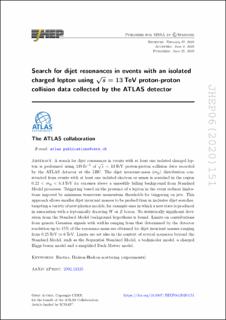Search for dijet resonances in events with an isolated charged lepton using √s = 13 TeV proton-proton collision data collected by the ATLAS detector
Aad, Georges; Abbott, Brad; Abbott, Dale C.; Abed Abud, Adam; Abeling, Kira; Abhayasinghe, Deshan Kavishka; Abidi, Syed Haider; AbouZeid, Ossama Sherif Alexander; Abraham, Nadine L.; Abramowicz, Halina; Bjørke, Kristian; Bugge, Magnar Kopangen; Cameron, David Gordon; Catmore, James Richard; Garonne, Vincent; Gramstad, Eirik; Hellesund, Simen; Morisbak, Vanja; Oppen, Henrik; Ould-Saada, Farid; Pedersen, Maiken; Read, Alexander Lincoln; Rye, Eli Bæverfjord; Røhne, Ole Myren; Sandaker, Heidi; Vadla, Knut Oddvar Høie; Buanes, Trygve; Djuvsland, Julia Isabell; Eigen, Gerald; Fomin, Nikolai; Lee, Graham Richard; Lipniacka, Anna; Martin dit Latour, Bertrand; Stugu, Bjarne; Træet, Are Sivertsen; Abreu, Henso; Abulaiti, Yiming; Acharya, Bobby S.; Achkar, Baida; Adachi, Shunsuke; Adam, Lennart; Adam-Bourdarios, Claire; Adamczyk, Leszek; Adamek, Lukas; Adelman, Jareed; Adersberger, Michael; Adigüzel, Aytül; Adorni, Sofia; Adye, Tim; Affolder, Anthony Allen; ATLAS, Collaboration
Journal article, Peer reviewed
Published version

View/
Date
2020-06Metadata
Show full item recordCollections
Abstract
A search for dijet resonances in events with at least one isolated charged lepon is performed using 139 fb−1 of s√ = 13 TeV proton-proton collision data recorded by the ATLAS detector at the LHC. The dijet invariant-mass (mjj) distribution constructed from events with at least one isolated electron or muon is searched in the region 0.22 < mjj < 6.3 TeV for excesses above a smoothly falling background from Standard Model processes. Triggering based on the presence of a lepton in the event reduces limitations imposed by minimum transverse momentum thresholds for triggering on jets. This approach allows smaller dijet invariant masses to be probed than in inclusive dijet searches, targeting a variety of new-physics models, for example ones in which a new state is produced in association with a leptonically decaying W or Z boson. No statistically significant deviation from the Standard Model background hypothesis is found. Limits on contributions from generic Gaussian signals with widths ranging from that determined by the detector resolution up to 15% of the resonance mass are obtained for dijet invariant masses ranging from 0.25 TeV to 6 TeV. Limits are set also in the context of several scenarios beyond the Standard Model, such as the Sequential Standard Model, a technicolor model, a charged Higgs boson model and a simplified Dark Matter model.
